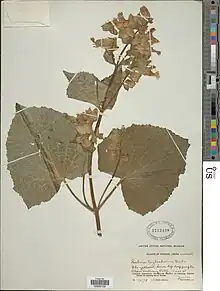| Salvia hylocharis | |
|---|---|
 | |
| Scientific classification | |
| Kingdom: | Plantae |
| Clade: | Tracheophytes |
| Clade: | Angiosperms |
| Clade: | Eudicots |
| Clade: | Asterids |
| Order: | Lamiales |
| Family: | Lamiaceae |
| Genus: | Salvia |
| Species: | S. hylocharis |
| Binomial name | |
| Salvia hylocharis | |
Salvia hylocharis is a perennial plant that is native to Xizang and Yunnan provinces in China, growing on grassy slopes, forest margins, and streamsides at 2,800 to 4,000 m (9,200 to 13,100 ft) elevation. S. hylocharis grows on one or two ascending to erect stems to 45 to 90 cm (18 to 35 in) tall. The leaves are ovate-triangular to ovate-hastate, typically ranging in size from 3 to 8.5 cm (1.2 to 3.3 in) long and approximately 8.5 cm (3.3 in) wide, though they sometimes are larger.
Inflorescences are racemes or raceme-panicles up to 25 cm (9.8 in), with a yellow corolla that is 3.5 to 3.8 cm (1.4 to 1.5 in), occasionally smaller.[1]
Notes
- ↑ "Lamiaceae" (PDF). Flora of China. Harvard University. 17: 159. 1994. Archived from the original (PDF) on 2010-07-14.
This article is issued from Wikipedia. The text is licensed under Creative Commons - Attribution - Sharealike. Additional terms may apply for the media files.